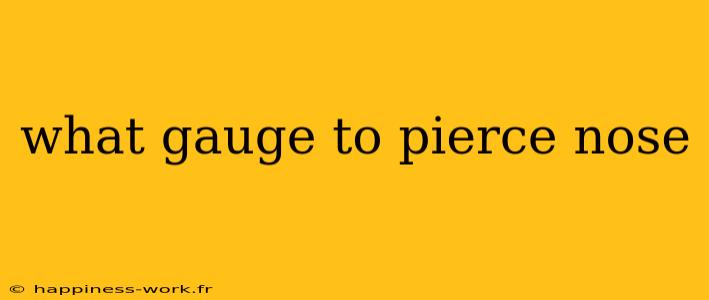Nose piercings have become increasingly popular, making them a fashionable accessory for individuals looking to express themselves. However, one of the most common questions that arise when considering a nose piercing is, "What gauge should I use?" This article aims to provide clarity on nose piercing gauges, offering insights, practical examples, and valuable tips to ensure a successful piercing experience.
Understanding Nose Piercing Gauges
A gauge measures the thickness of the needle or jewelry used in the piercing process. In body modification, a lower gauge number indicates a thicker piece of jewelry, while a higher gauge means a thinner one. The most common gauges for nose piercings range from 20 gauge to 16 gauge.
Common Gauges for Nose Piercings
-
20 Gauge (0.8 mm): This is the most common gauge for nostril piercings. It is considered a standard size and accommodates a wide variety of jewelry styles, including studs, hoops, and more elaborate designs.
-
18 Gauge (1.0 mm): This slightly thicker gauge is less commonly used but can be found in specific styles or for those who prefer a sturdier look. It can still be comfortable for most people but may feel a bit bulkier than a 20 gauge.
-
16 Gauge (1.2 mm): This gauge is suitable for those looking for a more substantial look and can be used for septum piercings as well. It's essential to note that choosing a thicker gauge can make the healing process slightly more uncomfortable.
Why Gauge Matters
Choosing the appropriate gauge for your nose piercing can significantly affect your healing process and overall comfort. Using too thick a gauge may lead to unnecessary pain and longer healing times, while a thinner gauge may not provide the durability or presence some individuals desire.
Healing Considerations
When deciding on the gauge, consider the following healing aspects:
-
Thicker Gauges: While they may seem durable, they can take longer to heal and may cause more swelling and irritation during the healing process.
-
Thinner Gauges: These are typically less invasive and allow for a quicker healing time. However, they may bend or warp more easily, requiring you to be more cautious during healing.
Additional Factors to Consider
-
Jewelry Material: Along with gauge size, the material of the jewelry is crucial. Surgical steel, titanium, or gold are excellent options that minimize irritation and prevent allergic reactions.
-
Personal Preference: Ultimately, the right gauge for you may also depend on your style preference and how prominent you want your piercing to be.
-
Professional Advice: Before making a decision, consult with a professional piercer. They can assess your anatomy and provide personalized recommendations based on your skin type and lifestyle.
Practical Examples
-
For Beginners: If you’re new to piercings, starting with a 20 gauge is a safe bet. This allows for various jewelry styles while keeping discomfort minimal during the healing process.
-
For Unique Styles: If you’re considering a septum piercing, you might opt for a 16 gauge. This offers a bolder look and can support heavier jewelry designs.
-
For Allergic Reactions: If you have sensitive skin, choose titanium or surgical steel in a 20 gauge to reduce the risk of irritation.
Conclusion
Choosing the correct gauge for your nose piercing is crucial to ensure comfort, healing, and style. Whether you decide on a 20 gauge for its versatility, an 18 gauge for something slightly bolder, or a 16 gauge for a statement piece, always prioritize quality materials and professional advice to ensure a positive experience.
For additional detailed information on nose piercings, you can refer to the original sources on WikiHow by their authors, which provide valuable insights into body modification practices.
References:
- WikiHow contributors on piercing and body modification practices.
By following the guidance outlined in this article, you can ensure that your nose piercing journey is not only aesthetically pleasing but also safe and comfortable. Happy piercing!
